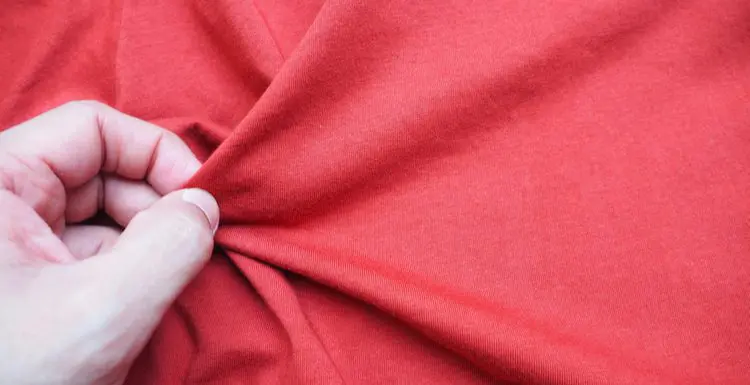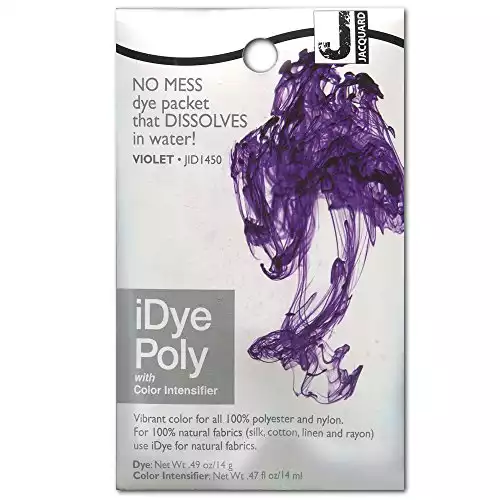Can you dye polyester, and how do you do it?
You can dye polyester material when using the right type of dye and the dyeing process.
You must use disperse dyes, which are designed specifically for polyester and other insoluble fabrics.
The fabric also needs to be heated for the fibers to absorb the dye.
How to Dye Polyester in 8 Easy Steps
The most effective way to dye polyester material involves using the same types of dyes used by manufacturers.
Disperse dyes are sold as powders. The powder is not water-soluble, which keeps it from dissolving in liquid at room temperature.
The water must be heated to boiling to open the fibers in the fabric and allow the pigments in the dye to stick.
Here are the steps involved in dyeing polyester fabric:
- Buy a synthetic dye and gather supplies
- Prepare the polyester material
- Pour water in a large pot
- Bring the pot to a boil
- Add the dye packet to the water
- Add the polyester material
- Rinse the polyester material
- Wash and air-dry your polyester items
There are also a few things to consider before trying to dye polyester material. Dyeing your polyester clothes or fabrics won’t fix certain signs of wear and tear.
Stains and bleach marks may still be visible even if you use a dark dye.
The base color of the fabric also impacts the results of the dyeing process. For example, you can’t dye black polyester cloth a lighter color.
If you add yellow dye to a blue shirt, you’ll likely get a green color. You should also inspect the clothing or fabric to check the materials.
Not all polyester products are made with 100% polyester fibers. For example, a polyester blend made with cotton or other natural fibers may not work well with synthetic colorants designed for polyester.
You may also find it hard to dye polyester fabrics made with spandex. Spandex cannot withstand the temperatures needed during the dyeing process.
If the polyester comprises less than 35% of the material, use a standard fabric dye instead of a dispersed dye.
Standard fabric dyes are easy to apply, as you typically need to soak the clothes in a tub with water and the dye. For 100% polyester and polyester blends, stick with dispersed dyes.
1. Buy a Synthetic Dye and Gather Supplies
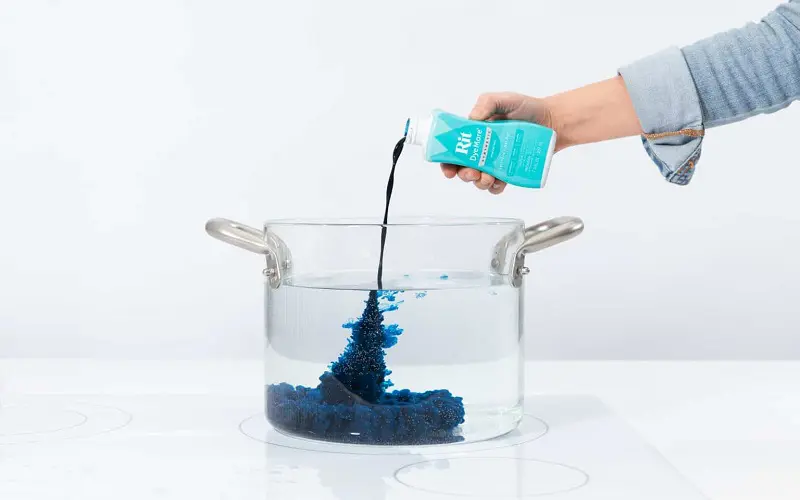
Image Source: Ritdye.com
You’ll need the following items to dye polyester items:
- Disperse dye
- Large cooking pot
- Water
- Tongs
- Oven mitts
- Sink
- Long wooden spoon
- Timer
A synthetic disperse dye is the best solution for dyeing polyester fabric. Standard dyes are water-soluble and don’t easily adhere to the synthetic fibers in the polyester material.
An all-purpose fabric dye may slightly alter the color of the polyester cloth but doesn’t offer the same results as disperse dyes.
You’ll also need a pot that is large enough to hold the polyester material that you want to dye.
As the water needs to stay boiling for about 30 minutes, the pot also needs to be able to rest on the stovetop.
2. Prepare the Polyester Material
Wash the material that you want to dye. Inspect the fabric for stains and dirt, as you want to remove any blemishes before you start the dyeing process.
Use stain remover if necessary, and wash the material again.
Don’t use fabric softener when drying the clothes. The softener and other treatments may interfere with the ability of the dye to adhere to the polyester fibers.
Wait until the polyester fabric is completely dry before you start dyeing.
3. Pour Water in a Large Pot
Set a pot on the stovetop and add water. Follow the instructions on the dye that you purchase. The label should tell you how much water to add.
The amount of water typically depends on the weight of the clothing. For example, you may need three gallons of water for every pound of fabric.
A large polyester jacket may weigh about four pounds, which would require 12 gallons (48 quarts) of water.
The typical large cooking pot has a capacity of 8 to 12 quarts, which can hold about two to three gallons.
With a 12-quart pot, you can dye about one pound worth of clothing. Weigh the clothing that you want to dye using kitchen scales.
If you want to dye multiple articles of clothing, you may need to repeat the dyeing process multiple times.
4. Bring the Pot to a Boil
You need boiling water for the fibers to soften and adhere to the pigments in the dye. It may take 8 to 15 minutes for the water to start boiling.
Some manufacturers state the recommended water temperature, which may vary from 140 degrees Fahrenheit to 200 degrees Fahrenheit.
If the water starts to boil, it should be within the right temperature range. You can also use a metal food thermometer to ensure that you get the right temperature.
5. Add the Dye Packet to the Water
Depending on the product you buy, you may have a packet or a large container of dye. Individual packets are easier to use, as you simply need to rip open the packet and pour the contents into the water.
If the dye comes in a container, follow the instructions on the label to measure the dye.
6. Add the Polyester Material to the Pot
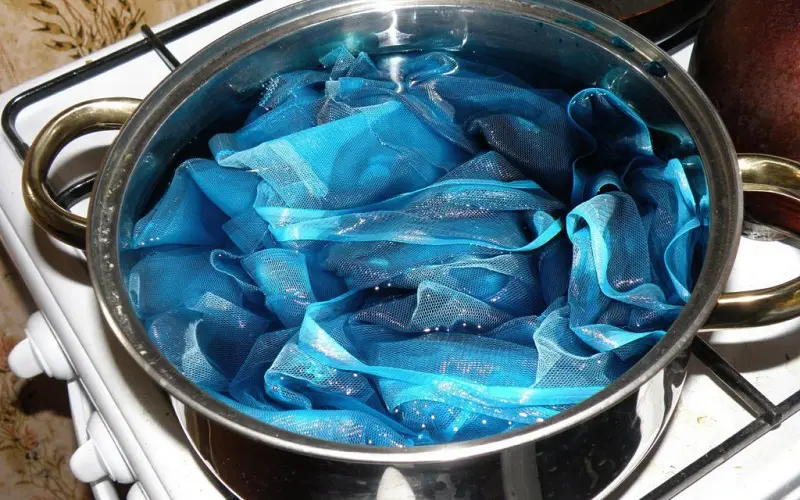
Image Source: Fashion-Decorexpro.com
After adding the dye, add the polyester material. Slowly lower the material into the pot to keep the water from splashing out.
Use a long wooden spoon to gently stir the polyester, the dye, and the boiling water. Stir continuously for ten minutes.
Set a timer to avoid agitating the polyester material for too little or too long. If you don’t agitate it for long enough, the dye may not adhere to the fibers.
If you agitate it for too long, you risk damaging your clothes. Keep the polyester item in the pot for at least another 20 minutes after you finish stirring.
7. Rinse the Polyester Material
After 30 minutes of soaking in boiling water, carefully remove the polyester clothes or fabric from the pot and run under warm water in a sink or bathtub.
To avoid scalding your skin, grab the polyester material with a pair of tongs. You may also want to wear oven mitts. Turn on the water in the sink or tub before bringing over the fabric.
Rinse the clothes in warm water for about a minute before gradually making the water cooler. Continue to rinse the clothes until the water runs clear.
8. Wash and Air Dry Your Polyester Fabric
Wash the clothes using a warm wash cycle without any other clothing. Allow the material to air-dry.
You may want to avoid washing with other clothes for at least a few washes.
After the initial washing and drying, wash the freshly dyed polyester material in cold water to help protect the colors from fading.
How to Dye Polyester Using Different Dyes
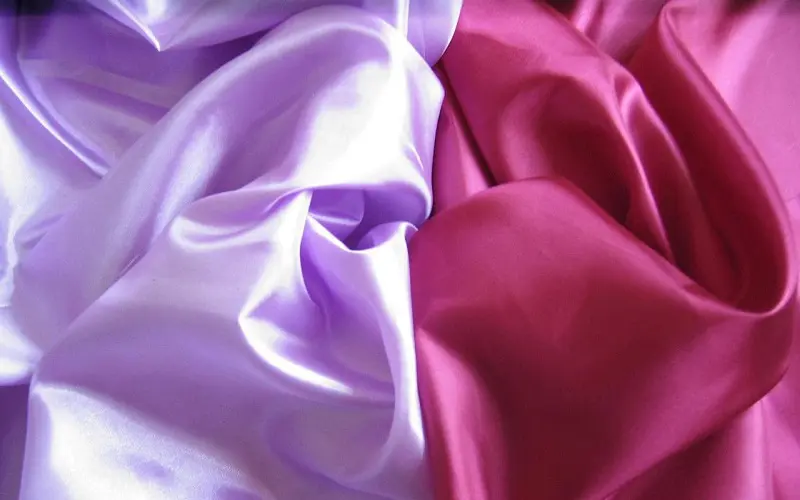
Image Source: Fabricgateway.com
Since polyester is not a natural fiber, it doesn’t absorb dyes as easily as natural fibers like cotton and wool. However, specific dyes like disperse dyes and Rit can successfully dye polyester.
In this guide, we’ll discuss how to dye polyester with various dyes to achieve the best results.
Acrylic Paint
Acrylic paint is usually water-based, making it an excellent choice for dyeing polyester. Double-check that your acrylic paint is solvent-free, as solvents would ruin the fabric.
Use a fabric medium with acrylic paint to ensure the clothing accepts the dye.
Below are some quick instructions to prepare the acrylic paint properly:
- Shake the bottle vigorously to ensure the pigments and liquids are thoroughly mixed. This step prevents thin paint or uneven thickness when working with the dye.
- After shaking it, mix one part fabric medium with two parts acrylic paint.
Now that your paint is ready, you can dye your fabric. However, we recommend gently dampening the cloth and using a brush or roller to apply the paint.
Let the acrylic paint dry for at least 24 hours before washing.
Dylon
Dyeing fabric with Dylon should only be done if your clothing is a blend of natural and synthetic.
However, if too much synthetic fiber is in the blend, Dylon becomes ineffective. Thus, the fabric you’re dyeing should have no more than 20% of the synthetic element.
Dylon is an easy-to-use fabric dye you can put in your washing machine to dye your clothing or even by hand.
We recommend choosing a darker dye pack than the shade you want, as Dylon dye doesn’t bond well with polyester fibers.
Follow the steps below to dye your polyester fabric:
- First, ensure the cloth you’re dyeing is damp and clean to allow it to absorb the dye easily.
- Put it in the washing machine and run a cycle as you normally would.
- Run another cycle with laundry detergent to remove the extra dye.
- Remove the clothes and run your washing machine on empty once or twice to ensure the dye is gone.
Remember to wash these fabrics separately from other clothes to make them last longer.
Disperse Dyes
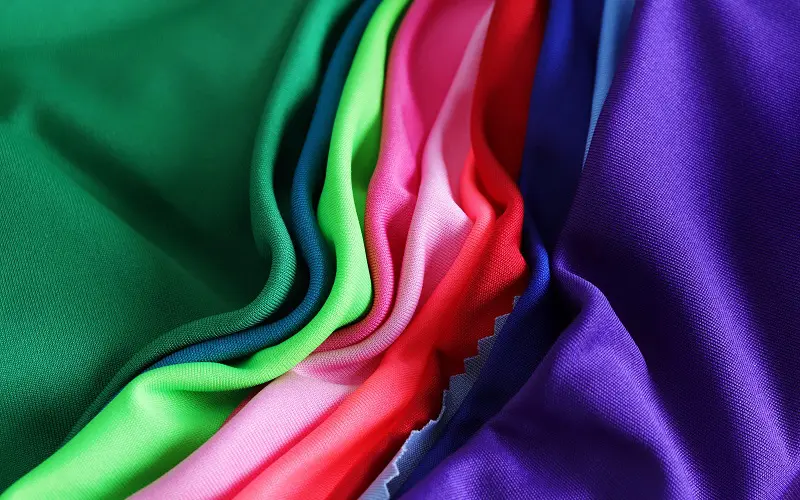
Image Source: Inquisitive.com
Disperse dyes are a great option for dyeing polyester since the dye bonds well with synthetic fibers. These dyes require specialized steps to dye polyester, mainly using a high temperature and a dispersing agent.
While the procedure for dyeing polyester with disperse dyes varies depending on the dye, the process usually goes as follows:
- Fill a large pot of water, mix in the specified disperse dye and dispersing agent, and heat it to the temperature mentioned on the label.
- Add the fabric you want to dye, and stir the mixture for at least 30 minutes.
- Remove the fabric after that and rinse with warm water.
- After this, wash with a mild detergent to remove excess dye.
Maintain the proper temperature for the dye to absorb evenly and thoroughly into the fabric.
Rit
Standard Rit Dye will not work with fabric that contains more than 35% synthetic content, but Rit DyeMore will. This dye is specifically designed to work on synthetic fibers like polyester.
Before dyeing using Rit DyeMore, there are some things you need to ensure:
- To dye your fabric using Rit DyeMore, use the stovetop method. A high water temperature is essential for the process to work. Thus, a washing machine won’t do.
- Ensure the fabric you’re dyeing is white or close to it to achieve the desired color.
- Use one bottle of Rit DyeMore per two pounds of dry polyester fabric. Double the dye quantity if the fabric is 100% polyester.
To begin the dyeing process, wait until the stovetop’s water starts boiling. When the water begins to simmer, add the specified quantity of Rit dye and mix well. Then add your wet fabric to the pot.
Keep the stove at a low simmer and stir the fabric and mixture slowly for 30 minutes. After, remove the cloth and rinse it under warm water, followed by cool water, until excess dye is removed.
Food Coloring
While it’s possible to dye polyester with food coloring on pure polyester fabrics, it will not adhere at all.
However, the coloring acts as a temporary dye on blended fabrics and will be removed after the first wash.
To use food coloring as a temporary dye, follow the steps below:
- Fill a pot with hot water enough to submerge the fabric.
- Add several drops of food coloring.
- Add a tablespoon of white vinegar as a pH modifier.
- Stir the mixture for at least 30 minutes before removing the fabric.
- Rinse off excess coloring and vinegar with warm water, followed by cold water.
Food coloring can only be used as a temporary option. For a more permanent dye job, we recommend you use one of the above methods to dye your polyester fabric.
Which Fabric Do You Suspect Will Be the Most Difficult to Dye
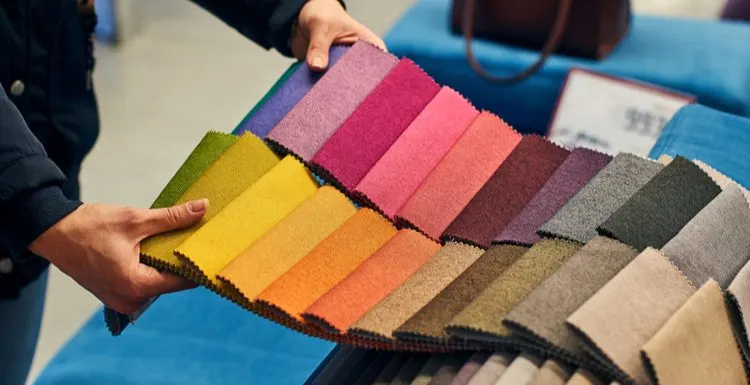
Oleksandr Berezko/Shutterstock
The hardest fabrics to dye will likely be synthetic materials. We are speaking about polyester and acrylic. Synthetic fibers don’t absorb paint as easily.
You’ll especially feel the difference with natural fibers like cotton or wool.
Also, some fabrics have special finishing additives. They make them water-resistant or crease-resistant. Such special finishes can make it difficult for dyes to adhere to the material. Among such fabrics, we highlight nylon and spandex.
It is best to follow the manufacturer’s instructions. Only then can you dye these types of fabrics.
What Are Some Tips for Successful Polyester Dyeing?
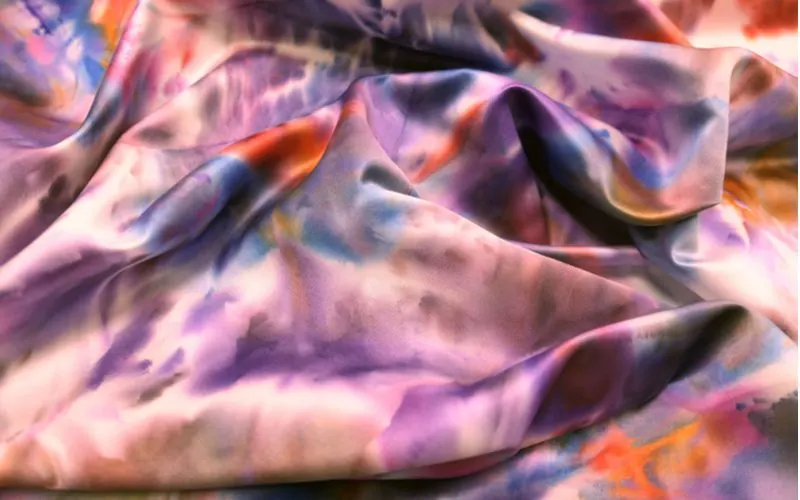
Tactexchang/Shutterstock
To ensure that your dyeing is top-notch, we recommend following some tips:
- Use a high-quality dye.
- Prepare the fabric first.
- Use plenty of water and stir
Look for a high-quality acid or reactive dye. Manufacturers design them specifically for synthetic fabrics.
You need to pre-treat the fabric with a fixative. Popular fixatives include Synthrapol or soda ash. This way, you will ensure proper adhesion of the dye.
Make sure that you use enough water. You should stir it constantly throughout the entire dyeing process. It will help ensure that the color is evenly saturated. And you will also minimize the appearance of streaks and stains.
Following these tips will help you successfully dye polyester in 2023! Remember to experiment with colors, patterns, and textures for truly unique results!
With a little patience and practice, you can create beautiful pieces that will last you for years. Good luck!
Final Thoughts
The easiest way to dye polyester material is to use disperse dyes in a pot of boiling water.
You can also try dying polyester fabric with food coloring or acrylic paint, but the results may not last or match your expectations.

